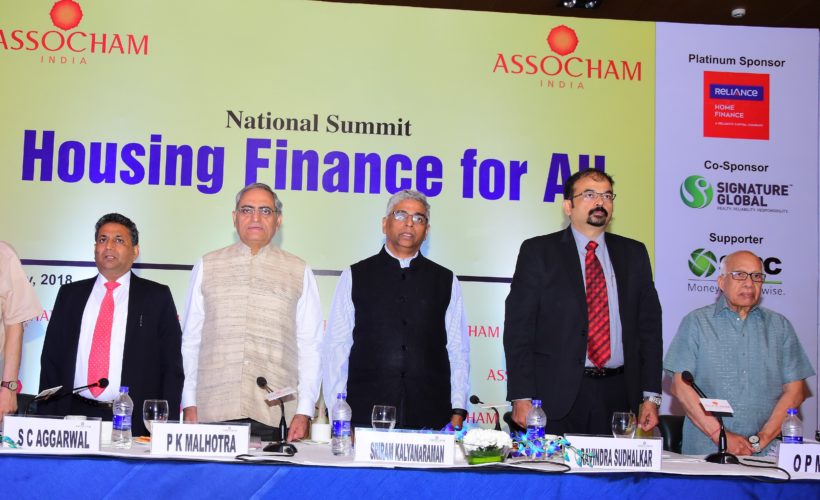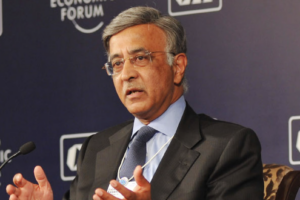
Easy and dedicated access to institutional financing, higher limit on external commercial borrowings (ECB) will attract more investments and assure sustained growth of affordable housing in India, making it the core driving segment for real estate, said Mr Sriram Kalyanaraman, Managing Director & CEO, National Housing Bank at an ASSOCHAM event held in New Delhi on Thursday.
The Foreign Direct Investment (FDI) and Foreign Institutional Investors (FIIs) will play a key role in boosting supply of houses and infra projects in urban areas, said Mr Sriram Kalyanaraman, Managing Director & CEO, National Housing Bank while inaugurating an ASSOCHAM National Summit on Housing Finance for All.
Mr. Ravindra Sudhakar, Co-Chairman, ASSOCHAM National Council, on Affordable Housing and Executive Director & CEO, Reliance Home Finance Limited said “While the progress made in housing sector development is commendable, it must be driven at an accelerated pace hereon. We – financiers, builders, banks -must accelerate our efforts in achieving the goal of housing for all.
“On the other hand, long term financing at lower rates will reduce costs of construction for developers allowing them to pass on benefits to consumers. Also, in India there is a need to develop a secondary mortgage market either in the form of RMBS (Reverse Mortgage Backed Securities) or Covered Bonds. Simplification of external commercial borrowing (ECB) guidelines has opened a new window of funding for housing finance companies in India, increasing the prospects of a fresh round of overseas borrowings”, said Kalyanaraman.
The Real Estate Investment Trust (REIT) is another instrument that has potential to transform the Indian real estate sector, especially in commercial real estate and rental housing. The advent of REITs in India has been greeted with a lot of enthusiasm by many market players, added Mr. Kalyanaraman.
“For addressing these issues, the Government has taken various steps to improve urban infrastructure like Swachh Bharat Mission (SBM, urban), Atal Mission for Rejuvenation and Urban Transformation (AMRUT), Heritage City Development and Augmentation Yojana (HRIDAY), Smart Cities, and Housing for All Mission. Under the Smart Cities Mission, 99 cities have been selected with a total outlay of Rs. 2.04 lakh crore ($31 billion)”.
Despite being centers of opportunity, the cities of India bring with them a host of environmental and infrastructure challenges, from pollution to lack of civic amenities like drinking water, sewage, housing and electricity, which disproportionally impacts the more vulnerable poor population, said Mr. Kalyanaraman.
‘The challenges that this sector faces are multidimensional and require the support of all stakeholders. They can be summarized as 3A’s (Availability, Accessibility and Affordability), and Sustainability.Availability of long term low cost fund is still the biggest challenge for the housing sector’.
The Government has accorded top priority for housing and put it on a growth trajectory not only by offering tax and fiscal incentives for builders and consumers, but also through structural reforms and single window clearance to improve transparency and disclosures to attract domestic and foreign investments.
The Union Budget 2018-19 affirmed the thrust on promoting affordable housing, by announcing the establishment of a dedicated Affordable Housing Fund (AHF) in National Housing Bank, funded from priority sector lending shortfall and fully serviced bonds authorized by the Government of India. This will make available low cost long term fund for financing affordable housing, said Mr. Kalyanaraman.
For PMAY (U), the Union Budget 2018-19 has provided Rs. 6,500 crore ($1 billion) through Gross Budgetary Support and Rs. 25,000 crore ($3.8 billion) through Internal and Extra Budgetary Resources under the Ministry of Housing and Urban Affairs (MoHUA). Comparing the quantum of requirement, this would require to be supported by market investment on a large scale.
Further with the grant of Infrastructure status to Affordable Housing and the implementation of Pradhan Manti Awas Yojana (PMAY) under Housing for All by 2022 Mission are some of the proactive decisions taken by the Government to usher affordable housing into a new era. The PMAY will provide a big boost to the housing sector, enabling million households to own a roof, especially those living at the bottom of the pyramid.
Under the PMAY (U), the MoHUA has sanctioned construction of 44.35 lakh affordable houses for urban poor with an investment of Rs. 2,50,977 crore ($39 billion), with a central assistance of Rs. 68,416crore ($10.5 billion). In 2018-19 alone, the government aims to construct 37 lakh houses for Economically Weaker Section (EWS) and Low Income Group (LIG) segments of people under the Scheme. If an average house under this Scheme is costing Rs. 10 lakh with Centre & State Government’s subsidy component of about Rs. 4 lakh, it would amount to investment requirement of about Rs. 2.2 lakh crore ($34 billion) in FY 2018-19 itself.
Under the PMAY (U) Credit Linked Subsidy Scheme, NHB has disbursed Rs. 3,018 crore against 1,40,943 units. Under the EWS/LIG scheme, we have disbursed Rs. 2,436 crore against 1,13,081 units and under the MIG scheme, we have disbursed Rs. 582 crore against 27,862 units.
Pradhan MantriAwaasYojana (Gramin) has been made effective from April 1, 2016 with immediate objective to cover 1 crore households living in kutcha house/dilapidated houses in three years 2016-19. The minimum size of the house has been increased to 25 sq. m. (earlier 20 sq. m.) with a hygienic cooking space. As stated in the Union Budget, under the PMAY(Gramin), 49 lakh houses will be constructed and the outlay for the programme stands at Rs. 33,000 crore, Mr. Kalyanaraman.



